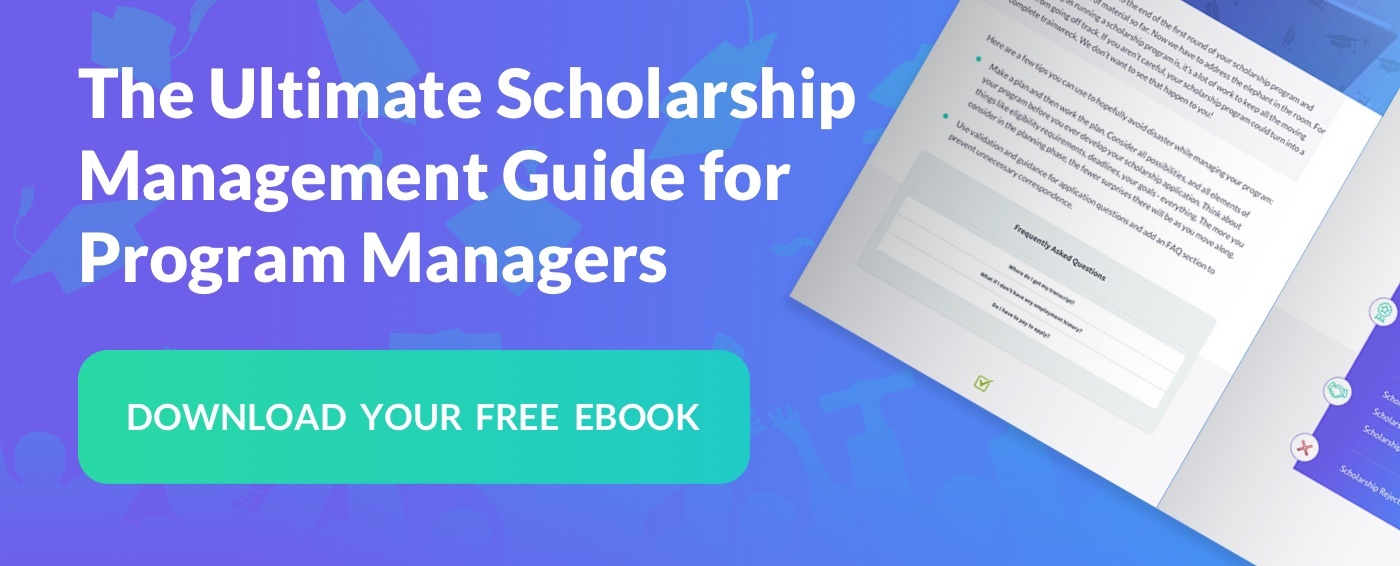Run Efficient Application Reviews for your Scholarships Program
You set up a scholarship program, and hopefully people apply. Then, comes what is hands down the most arduous and time-consuming part of the process - the application review of each and every form that has been submitted.
Get it right, and you can smoothly go about selecting your recipient or recipients with efficiency and a good degree of ease. Get it wrong, and you could spend untold amounts of time and energy only to be left with too many people you want to give the money to.
The keys to running an efficient application review process for scholarships are:
- Select a top-notch review team
- Set up definitive criteria for scholarship awards
- Have an effective scholarship rubric in place
- Use scholarship management software
Now that you know the keys, let’s explore what this looks like in practice.
Set Up The Ideal Scholarship Review Team
The first thing you need to ask yourself as you are putting your team together is, who is your ideal reviewer? You want to select team members that match the vision of your scholarship program. They will be most effective in choosing recipients that align with your program’s objectives and values.

For example, if the candidate works in or is a teacher for the field the scholarship is intended for, they may be a good fit. Or if they don’t work in the field, consider their characteristics and whether or not they match those you would expect of an award recipient.
If the candidate doesn’t fit these criteria or have values that are in line with your scholarship, it’s best to move onto someone else.
Next, you need to decide how many reviewers you will need. Consider how much time each application review will take. For simplicity’s sake, we’ll assume that a single team member can review 10 applications in an hour. With that in mind, if 1,000 applications come in, that one team member will need at least 100 hours, or roughly two and a half weeks (assuming a 40 hour work week) to review all of them.
With scholarship management software you might be able to lower the amount of time it takes to review applications, but we’ll address that in a moment.
What if you receive 10,000 applications? Or 20,000? Now, you’re talking about some serious time commitments, and you’ll need additional team members to help you move through your application review period quickly.
Hopefully, these simple numbers give you a rough estimate of how many team members you may need to prepare to bring on board. Once you decide how many people will be necessary for your team, it’s time to start recruiting.
Before you begin your outreach, you will need to decide if you’re looking for volunteers or if this will be a temporary paid assignment. In the event that you will be paying your team members, it may be best to work with a work placement agency who can manage the recruitment for you. If you are recruiting volunteers, however, there are several places you can look for help.
If you run a non-profit, and the scholarship program is part of that organization, you can work with local colleges to fill your team with individuals seeking on the job training and/or community service hours.
Then again, even if your scholarship program is part of a for-profit organization, you may be able to recruit temporary college interns for your application review season. Just make sure you abide by the rules of the colleges you are working with to ensure that interns get class credit for their time.
Non-profit and for-profit businesses can also look at the following sources for team member recruitment:
- Organization volunteers
- Current and past clients, partners, vendors
- Past scholarship recipients
- Social media
- Your email list
With your team in place, it’s time to get to the evaluations!
Put Systems in Place to Run an Efficient Scholarship Review Process

All things considered, filling the seats on your application review team is an easy job compared with picking your recipient or recipients. The good news is, you can make the task a little easier and less time-consuming with scholarship management software and a system for reviewing applicants.
The system you create may take some trial and error in the beginning, but once you get a good process in place, you can repeat it for all future scholarship programs you run.
- Add application rules to your scholarship application in your software. This will streamline the process right off the bat because it will dynamically change the questions in the application based on the user’s answers. By the time the applicant reaches the end of the form, it may already be clear that they are not a good fit for the award.
- Create a scoring rubric that quickly filters out ineligible applicants. Using the software, you can automatically score answers for qualitative values. For example, if you only want to award people who have a GPA higher than 3.0, and SAT scores of a certain number, then anyone who has numbers below that is easily eliminated from the pool.
- Vet applications before the evaluations begin. Your vetting process may look different, but you can eliminate applicants that have not submitted all required documentation, answered all questions, or that didn’t complete their essays. Additionally, if your scholarship is financially need-based and the applicant doesn’t meet that qualifier, they too could be eliminated before the evaluations even start. An easy-to-use reporting system is key here.
- Now that the pool is likely much smaller, you can begin assigning applications to evaluators. A simple way to do this is by divvying up the applications alphabetically. Using the software, you can do this with a few clicks of a button. How you divvy up applications for evaluators will be up to you.
For example, Martha will review last names that begin with letters A-C, John will review D-F, Sam will review G-I, and so forth and so on. Or if the applications have been assigned a number, you could divvy them up based on their application number. For example Martha reviews numbers 00001-00999, John reviews 01000-01999, and Sam reviews 02000-02999, etc… - From here, you’ll make sure all of your team members understand how to evaluate applications. What are you looking for in a scholarship recipient? Explain the rubric and answer questions that may be frequently asked. The more you can systematize, the better.
The goal is to make it easy for evaluators to give a hard yes, or a hard no to applicants. No in-betweens because these take longer to evaluate. Then, after the reviewer has a small group of potential “yes” applicants, the evaluations must become more stringent to continue making the pool smaller until you have between one and a handful of applicants per team member.
Next, you can debate as a group who the final recipients will be from that pool.

SmarterSelect Makes Application Review Faster and Easier
There are so many more things you can do to make the scholarship application review process more efficient. From evaluators sharing notes and custom reports to easy evaluation scoring, and automatic calculations, SmarterSelect makes it easier than ever before to run a top-level scholarship program.
The assistance doesn’t stop there, however. When you work with SmarterSelect to build your scholarship program, you will get access to our community forum where you can submit suggestions and read the suggestions and ideas of program developers that have started before you. You'll also get access to our online help center to learn the best methods to run your scholarship program and get answers to the most common questions we’ve seen. Request a demo to find out more.
We’ve helped countless program administrators make quick work of their own scholarships, and we can help you too. Click here to download our in-depth scholarship management guide for program managers.



